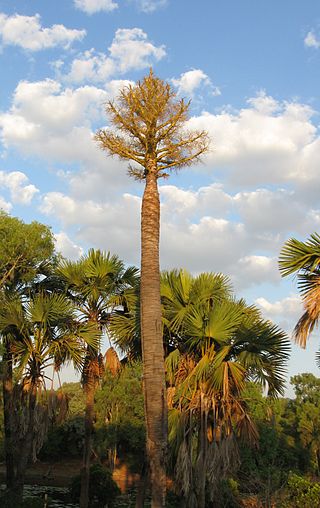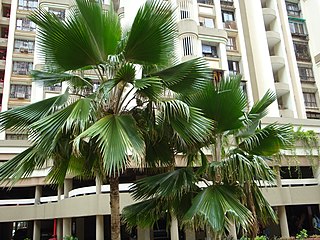
Aralia spinosa, commonly known as devil's walking stick, is a woody species of plant in the genus Aralia, family Araliaceae, native to eastern North America. The various names refer to the viciously sharp, spiny stems, petioles, and even leaf midribs. It has also been known as Angelica-tree.

Trachycarpus fortunei, the Chinese windmill palm, windmill palm or Chusan palm, is a species of hardy evergreen palm tree in the family Arecaceae, native to parts of China, Japan, Myanmar and India.

Sabal minor, commonly known as the dwarf palmetto, is a small species of palm. It is native to the deep southeastern and south-central United States and northeastern Mexico. It is naturally found in a diversity of habitats, including maritime forests, swamps, floodplains, and occasionally on drier sites. It is often found growing in calcareous marl soil. Sabal minor is one of the most frost and cold tolerant among North American palms.

Corypha or the gebang palm, buri palm or talipot palm is a genus of palms, native to India, Malaysia, Indonesia, the Philippines, New Guinea and northeastern Australia. They are fan palms, and the leaves have a long petiole terminating in a rounded fan of numerous leaflets.

Arenga pinnata is an economically important feather palm native to tropical Asia, from eastern India east to Malaysia, Indonesia, and the Philippines in the east. Common names include sugar palm, areng palm, black sugar palm, and kaong palm, among other names.

Corypha umbraculifera, the talipot palm, is a species of palm native to eastern and southern India and Sri Lanka. It is also grown in Cambodia, Myanmar, Thailand and the Andaman Islands. It is one of the five accepted species in the genus Corypha. It is a flowering plant with the largest inflorescence in the world. It lives up to 60 years before bearing flowers and fruits. It dies shortly after.

Saribus rotundifolius, also known as the footstool palm, is a common fan palm found in Southeast Asia. It is a member of the genus Saribus.

Corypha taliera is a species of palm, originally native to Myanmar (Burma) and the Bengal region of India and Bangladesh. It was first discovered by Scottish botanist William Roxburgh. It has been listed extinct in the wild in the IUCN Red list. The species is locally known as Tali Palm or Talipalm.

Livistona tahanensis is a species of medium-sized palm tree of the genus Livistona, found on only one mountain top in Pahang, Peninsular Malaysia. In Malay the palm is known as Tahan serdang, or as daun tau.

Metroxylon is a genus of monoecious flowering plants in the Arecaceae (palm) family, and commonly called the sago palms consisting of seven species. They are native to Western Samoa, New Guinea, the Solomon Islands, the Moluccas, the Carolines and Fiji in a variety of habitats, and cultivated westward to Thailand and Malaya.

Sabal maritima is a species of palm which is native to Jamaica and Cuba.

Corypha utan, the cabbage palm, buri palm or gebang palm, is a species of palm native to Asia and Oceania.

Pritchardia pacifica, the Fiji fan palm, or piu, is a species of palm tree in the genus Pritchardia that is native to Tonga. It is also found in Fiji, Samoa, and the north-eastern part of India, and the Marquesas. However, these populations are likely to be human introductions.

Livistona saribus, also known as the swamp serdang or taraw palm, is a species of palm tree found in tropical Southeast Asia.

Cyrtostachys renda, also known by the common names red sealing wax palm and lipstick palm, is a palm that is native to Thailand, Malaysia, Sumatra and Borneo in Indonesia. It is the only species of the genus Cyrtostachys that can be found to the west of the Wallace Line, the faunal boundary separating the biogeographic realms of Asia and Wallacea. Cyrtostachys renda's name is derived from several words: the Greek prefix κυρτό- (cyrto-) meaning bent or curved, the Greek word σταχυς (stachys) meaning "an ear of grain", and "renda" a Malayan Aboriginal word for palm, which happens to be homonymous to the Portuguese word "renda," meaning income.

Pritchardia beccariana, the Kilauea pritchardia, or Beccari's loulu, is a species of palm tree in the genus Pritchardia that is endemic to wet forests on the eastern part of the island of Hawaiʻi, near Hilo.

Butia stolonifera was an oddly growing palm assigned to the genus Butia found only once in Uruguay in the 19th century, but which now is considered to be uncertain as a valid species.
Gunnera magnifica, commonly called hoja de pantano, is a large herbaceous shrub or tree-like plant native to the montane rainforests of the Colombian Andes in Caldas Province. It can grow as high as 4.7 meters The lower trunk is decumbent and rhizomatous, while the upper trunk is upright and palm-like. This pachycaul trunk is up to 40 centimetres thick. At the top is a rosette of huge leaves, the blade, or lamina of which is up to 115 cm (45 in) long by up to 184 cm in width. The stalk, or petiole is 2.4 meters in length and 8 to 10 cm in thickness. These huge leaves emerge from a bud up to two feet long by up to 16 inches (41 cm) wide; the largest leaf bud of any known plant. The panicle of red, dimerous flowers, panicle and pedicel combined, is up to 2.7 meters in height. The bud scales covering the terminal bud are up to 39 cm (15 in) in length by up to 7.5 cm wide, the largest of any known plant.

















